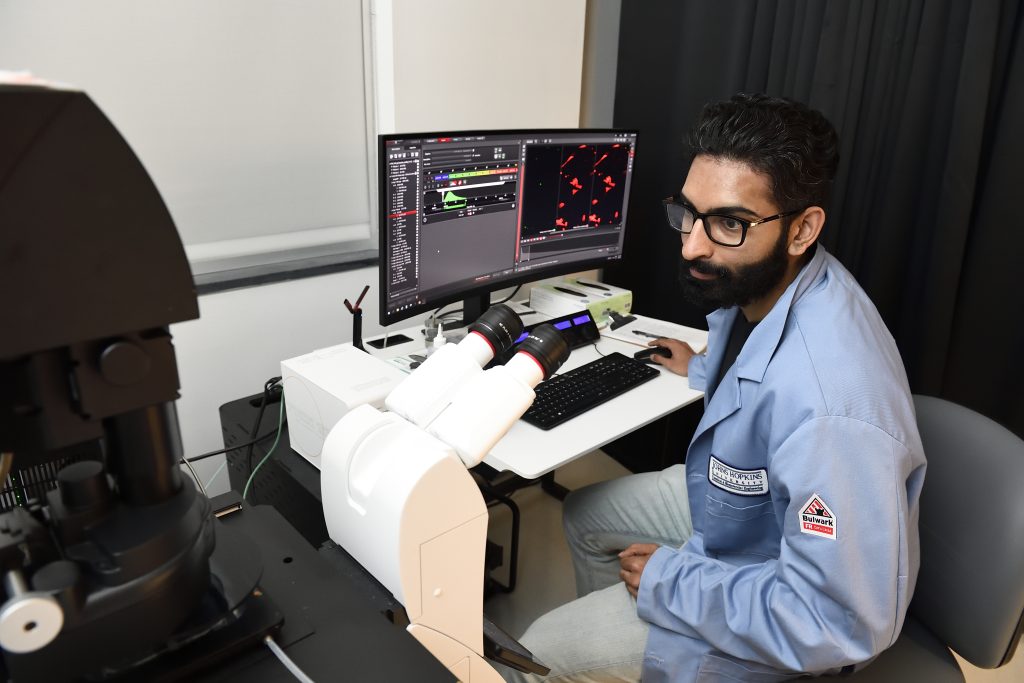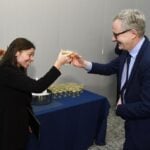Pratik Kamat takes aim at identifying biomarkers for healthier aging

When Pratik Kamat arrived at Johns Hopkins University after graduating from the University of Minnesota in 2020, he was unsure what research area he wanted to focus on. While he did not have a specified interest, he knew he wanted to grow his experimental and data analysis skills. Not long after he arrived on campus, he met aging expert Jude Phillip, core researcher at the Institute for NanoBioTechology and assistant professor in biomedical engineering. He invited Kamat to his lab to investigate cell senescence, a form of cell cycle arrest in which cells become resistant to growth, typically in response to DNA damage, while he figured out what topics interested him. Examining factors that affect the way a person ages, and if there are ways to change how they age for the better, piqued Kamat’s interests to study cell aging further.
Today, as a fourth-year chemical and biomolecular engineering PhD student, Kamat’s research centers on identifying aging biomarkers such as how cells of different chronological ages create and regulate proteins, and biophysical characteristics like their shape and how they move. “Aging is everyone’s experience,” Kamat said, “but there are a lot of ways in which we age differently. We’re looking to identify how lifestyle factors, like diet and exercise, as well as genetic factors affect aging.”
Moseman: What are the current challenges to studying aging?
Kamat: Aging is a relatively new and unexplored field. New discoveries and developments are happening all the time. While this is expected and helpful to grow the field, all of this new information causes unpredictable paradigm shifts in the basic fundamentals of the discipline. We’re lucky that we can overcome this and many challenges at Johns Hopkins because we can easily collaborate with experts and organizations across departments and schools. For example, Jude and I are engineers and we’re working with leading medical experts like Jeremy Walston, who heads the gerontology department at Johns Hopkins School of Medicine. It’s a cool part about doing research here.
Moseman: What should people know about aging and aging research?
Kamat: People might be surprised to learn about chronological versus biological aging. Chronological age is different from biological age. Chronological age is how many years one has been alive, while biological age gauges a person’s age based on the physiological functions of their body. For example, a person might have the chronological age of a 35-year-old, but their body functions similar to that of a 23-year-old or 50-year-old based on their lifestyle choices and genetics. Biological age is a better assessment of one’s true age as you can have people with the same chronological age but have wildly different qualities of life.
Also, people need to know that there is no panacea to stop or reverse aging. The best way to age healthy is to practice healthy lifestyle choices (diet, exercise, etc.) and, if needed, supplement with therapeutic interventions.
Moseman: What unexpected surprises did you discover in your research?
Kamat: Initially, Jude and I started working on senescence, which is a branch of aging. As we collected data, we found something interesting. We discovered that a cell’s morphology, that is their size, shape, and structure, tells us more about how they will respond to damaging agents than their chronological age. Thus, we believe a cell’s morphology strongly influences biological age and cellular functions. We said, “Hey! What if we use this as a marker to identify aging characteristics.” It was that initial project that got me started with my current research.
Moseman: What are your career plans after you finish your PhD?
Kamat: After graduate school I plan on exploring management consulting or operations-based professions that incorporate the business side of research while allowing me to do research. I’m also open to a traditional scientist role, but I’m not entirely sure which one I will pursue yet.
Moseman: What do you do when you are not doing research?
I’m currently president of the Johns Hopkins Graduate Consulting Club. It is interesting, because it gives me a lot of insight into the finances of a lab. What I think some people fail to realize is that every lab is like a small business. It really helps to understand inflows and outflows and running it like a small company. I’m also a big fan of going to the gym and trading card games, like Magic, although it is an expensive hobby to keep up with.
Latest Posts
-
 Cellular building blocks may enable new understanding of the body’s “machinery”
December 19, 2025
Cellular building blocks may enable new understanding of the body’s “machinery”
December 19, 2025
-
 Biomedical Engineer Jamie Spangler Receives President’s Frontier Award
December 15, 2025
Biomedical Engineer Jamie Spangler Receives President’s Frontier Award
December 15, 2025
-
 Johns Hopkins Postdoc Named in Forbes `30 Under 30′ List
December 8, 2025
Johns Hopkins Postdoc Named in Forbes `30 Under 30′ List
December 8, 2025


